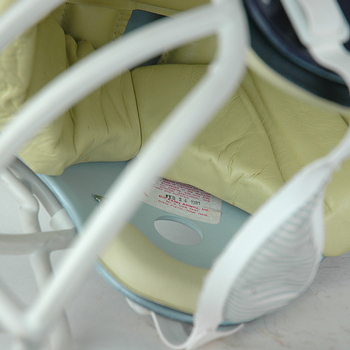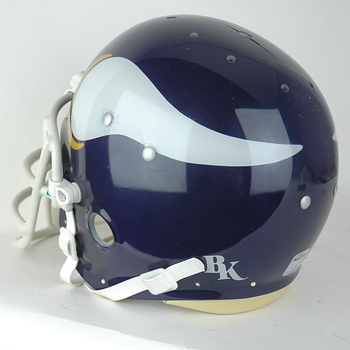

VIKINGS
1980 – 1984 MINNESOTA VIKINGS KELLEY CLEAR SHELL HELMET
|
|
|
When the Minnesota Vikings became a National Football League expansion entry for
the 1961 season, they entered with a no-nonsense uniform that featured a purple
helmet with Viking horns on each side, giving them an immediately identifiable
appearance. Crusty former veteran quarterback Norm Van Brocklin guided them as
the franchise’s first head coach and did so through what was expected to be a
few rocky seasons. Three and two-win seasons were followed by improvement and
the ’64 finish of 8 – 5 – 1 tied the new kids on the block for second place in
the Western Conference with the Packers. Backsliding in the next two seasons and
with reports of coach – player rancor fulminating, “The Dutchman” was replaced
by a more non-confrontational yet just as intense Bud Grant. After the
introduction of his system and methods in 1967, Grant’s Vikings reeled off an
incredible eleven Conference/Division championships in thirteen seasons with
four Super Bowl appearances. Entering 1979, the ’72 season at 7 – 7 was the only
roadblock to eleven consecutive championship outings.
|
|
|
|
 |
The white mask would remain until the 1985 season when a purple mask was
added to the purple shell but this would be a five year stretch that would
test the mettle of the loyal Vikings fans. Habituated to championship play
from their Bud Grant teams, 1980 seemed to be a “return to normal.” Even
national scribes bought into the narrative that ’79 was a mere blip on the
screen of Vikings domination. One wrote, “Enough of that rebuilding garbage.
The Vikings are back. For those of you who blinked your eyes, they slid to
third place in 1979 after Fran Tarkenton retired…Every team needs to back
off and adjust the dials once in a while. It was time for the Vikings to
tune the engine that had won 10 out of 11 NFC division titles. After all, it
had been tuned in 1972.” Unfortunately, the team needed more than a tune up
as they settled solidly into mediocrity with marks of 7 – 9, a strike
shortened season of 5 - 4, and 8 – 8 in ’83 which ended with the retirement
of venerated Coach Grant. Assistant Les Steckel, a former Marine, took the
helm for 1984 and imposing a disciplined system very much reflecting his
military background, saw the squad blow up with a 3 – 13 effort and a
palpable mutiny. This brought the out-of-retirement return of Grant for ’85
but no more than a 7 – 9 record. The Vikings were never truly terrible and
enjoyed a few marvelous seasons, but the established excellence of Grant’s
squads were past as the team settled into a run of average performances that
has in fact lasted for decades under a succession of coaches.
|
|
 |
With both Grant and his teams predictable in their demeanor, style of play, and game day philosophy, the departure to a white face mask was in fact, different and a bit daring for a franchise and coach that prided itself on incredible consistency. While most of the Vikings players of the Grant era wore the Riddell helmet, some utilized the Bill Kelley produced clear shell during the “white mask” years. The Kelley Geo model helmet remains a rare, true collector’s item, highly coveted especially when the identifying “BK” rear logo, pristine padded interior that was a continuation of the MacGregor style, and spotless shell indicate that this specific helmet was a prototype or sample that suffered not a mark on the field of play. The JOP white mask on this shell was more indicative of the 1980 and ’81 seasons than the latter part of the “white mask years.” Although many Vikings continued to wear this style, a majority of NFL players including most of the Vikings, had moved on to the more popular “double wire” style masks by the 1982 and ’83 seasons. While the period in which this wonderful Vikings helmet was worn did not quite match the championship production of Bud Grant’s “gray mask” era that preceded it, this clear shell Kelley helmet remains a unique beauty.